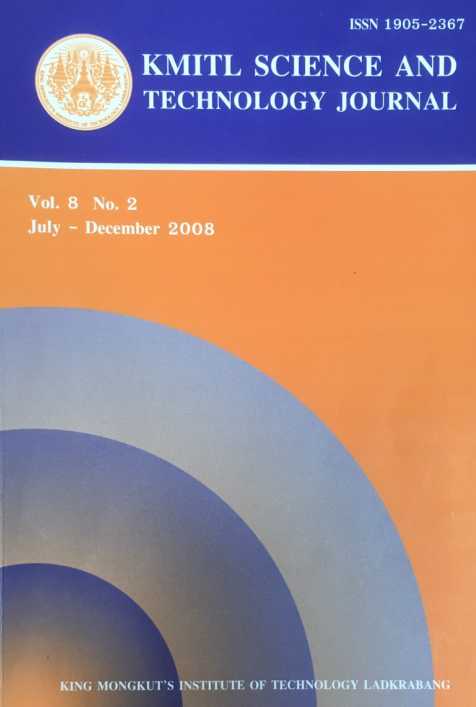The Use of Agricultural Wastes as Substrates for Cell Growth and Carboxymethyl Cellulase (CMCASE) Production by Bacillus subtilis, Escherichia coli and Rhizobium sp.
Main Article Content
Abstract
Bacillus subtilis ATCC 6633, Escherichia coli ATCC 25922 and Rhizobium sp. DASA23010 were examined for carboxymethyl cellulase (CMCase) production. CMCase produced from all strains was characterized as cell-bound enzyme. All strains could grow in medium containing CMC as a sole carbon source. The highest activities obtained from B. subtilis, E. coli and Rhizobium sp. were not significantly different. Comparing the growth in three agricultural wastes, maximum cell numbers were obtained from the media containing pineapple peel, vegetable residue and corncob,respectively. Corncob stimulated higher production of CMCase than other agricultural wastes.
KEYWORDS: Carboxymethyl cellulase, CMCase, Bacillus subtilis, Escherichia coli, Rhizobium, agricultural wastes
E-mail: neelawan@su.ac.th
Article Details
Copyright Transfer Statement
The copyright of this article is transferred to Current Applied Science and Technology journal with effect if and when the article is accepted for publication. The copyright transfer covers the exclusive right to reproduce and distribute the article, including reprints, translations, photographic reproductions, electronic form (offline, online) or any other reproductions of similar nature.
The author warrants that this contribution is original and that he/she has full power to make this grant. The author signs for and accepts responsibility for releasing this material on behalf of any and all co-authors.
Here is the link for download: Copyright transfer form.pdf
References
[2] Lynd, L. R., Weimer, P. J., van Zyl, W. H. and Pretorius, I. S. 2002. Microbial cellulose utilization: Fundamentals and biotechnology, Microbiology and Molecular Biology Reviews,66(3), 506–577.
[3] Zhou, S. and Ingram, L. O. 2000. Synergistic hydrolysis of carboxymethyl cellulose and acid-swollen cellulose by two endoglucanases (CelZ and CelY) from Erwinia chrysanthemi, Journal of Bacteriology, 182(20), 5676–5682.
[4] da Silva, R., Lago, E. S., Merheb, C. W., Macchione, M. M., Park, Y. K. and Gomes, E.2005. Production of xylanase and CMCase on solid fermentation in different residues by Thermoascus aurantiacus miehe, Brazilian Journal of Microbiology, 36(3), 235–241.
[5] Siddqui, K. S., Azhar, M. J., Rashid, M. H., Ghuri, T. M. and Rajoka, M. J. 1997.Purification and the effect of carboxymethylcellulases from Aspergillus niger and Cellulomonas biazotea, Folia Microbiologica, 42(4), 303–311.
[6] Kimura, S. Y., Yamamato, K. and Kumagai, H. 1995. Purification and characterization of a protease-resistant cellulase from Aspergillus niger, Journal of Fermentation and Bioengineering, 79(2), 125–130.
[7] Kundu, R. K., Dube, S. and Dube, D. K. 1988. Extracelluar cellulolytic enzyme system of Aspergillus japonicus: 3. Isolation, purification and characterization of multiple forms of endoglucanase, Enzyme and Microbial Technology, 10(2), 100–109.
[8] Glenn, M., Ghosh, A. and Ghosh, B. K. 1985. Subcellular fractionation of a hypercellulolytic mutant, Trichoderma reesei Rut-C30: Localization of endoglucanase in microsomal fraction, Applied and Environmental Microbiology, 50(5), 1137–1143.
[9] Pooyan, G. M.and Shamalnasab, M. 2007. Cellulase activities in nitrogen fixing Paenibacillus isolated from soil in N-free media, World Journal of Agricultural Sciences,3(5), 602–608.
[10] Chen, P., Wei, T., Chang, Y. and Lin, L. 2004. Purification and characterization of carboxymethyl cellulase from Sinorhizobium fredii, Botanical Bulletin of Academia Sinica,45, 111–118.
[11] Kurakake, M., Yo-u, S., Nakagawa, K., Sugihara, M. and Komaki, T. 2000. Properties of chitosanase from Bacillus cereus S1, Current Microbiology, 40(1), 6–9.
[12] Pedraza-Reyes, M. and Gutierrez-Corona, F. 1997. The bifunctional enzyme chitosanasecellulase produced by the gram-negative microorganism Myxobacter sp. AL-1 is highly similar to Bacillus subtilis endoglucanases, Archives of Microbiology, 168(4), 321–327.
[13] Kim, C. H. 1995. Characterization and substrate specificity of an endo-β-1,4-D-glucanase I(avicelase I) from an extracellular multi-enzyme complex of Bacillus circulans, Applied and Environmental Microbiology, 61(3), 959–965.
[14] Sami, A. J. and Akhtar, M. W. 1993. Purification and characterization of two low-molecular weight endoglucanases of Cellulomonas flavigena, Enzyme and Microbial Technology, 15(7),586–592.
[15] Pelletier, A. and Sygusch, J. 1992. Purification and characterization of three chitosanase activities from Bacillus megaterium P1. Applied and Environmental Microbiology, 56(4),844–848.
[16] Mateos, P. F., Jimenez-Zurdo, J. I., Chen, J. A., Squartini, S., Haack, S. K., Martinez-Molina,E., Hubbell, D. H. and Dazzo, F. B. 1992. Cell-associated pectinolytic and cellololytic enzymes in Rhizobium leguminosarum biovar trifolii, Applied and Environmental Microbiology, 58(6), 1816–1822.
[17] Kobayashi, T. M., Romaniec, P. M., Fauth, U. and Demain, A. 1990. Subcellulosome preparation with high cellulase activity from Clostridium thetmocellum, Applied and Environmental Microbiology, 56(10), 3040–3046.
[18] Reynolds, P. H. S., Sissons, C. H., Daniel, R. M. and Morgan, H. W. 1986. Comparison of cellulolytic activities in Clostridium thermocellum and three thermophilic, cellulolytic anaerobes, Applied and Environmental Microbiology, 51(1), 12–17.
[19] Calza, R. E., Irwin, D. C. and Wilson, D. B. 1985. Purification and Characterization of Two β-1,4-Endoglucanases from Thermonospora fusca, Biochemistry, 24(26), 7797–7804.
[20] Nakamura, K. and Kitamura, K. 1983. Purification and some properties of a cellulase active on crystalline cellulose from Cellulomonas uda, Journal of Fermentation Technology, 61,379–382.
[21] Qi, B., Yaoa, R., Yua, Y. and Chena, Y. 2007. Influence of different ratios of rice straw to wheat bran on production of cellulolytic enzymes by Trichoderma viride ZY-01 in solid state fermentation, Electronic Journal of Environmental, Agricultural and Food Chemistry, 6(9),2341–2349.
[22] Keele Jr, B. B., Hamilton, P. B. and Elkan, G. H. 1969. Glucose catabolism in Rhizobium japonicum, Journal of Bacteriology, 97(3), 1184–1191.
[23] Pongsilp, N., Teaumroong, N. A., Nuntagij, N., Boonkerd, and Sadowsky, M. J. 2002. Genetic structure of indigenous non-nodulating and nodulating populations of Bradyrhizobium in soils from Thailand, Symbiosis, 33, 39–58.
[24] Zorreguieta, A., Finne, C. and Downie, J. A. 2000. Extracellular glycanases of Rhizobium leguminosarum are activated on the cell surface by an exopolysaccharide-related component,Journal of Bacteriology, 182(5), 1304–1312.
[25] Bergmeyer, H. U. 1988. Methods of enzymatic analysis metabolites 1: Carbohydrates. Vol VI.Florida, VCH Publishers.
[26] Jimenez-Zurdo, J. I., Mateos, P. F., Dazzo, F. B. and Martinez-Molina, E. 1996. Cell-bound cellulase and polygalacturonase production by Rhizobium and Bradyrhizobium species, Soil Biology and Biochemistry, 28(7), 917–921.
[27] Horikoshi, K. M., Nakao, Y. Kurono, and Sashihara, N. 1984. Cellulase of an alkalophilic Bacillus strain isolated from soil, Canadian Journal of Microbiology, 30(6), 774–779.


